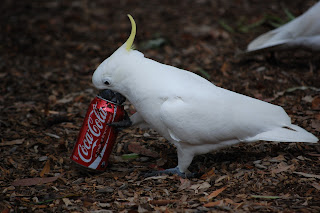I started the day with a 3 mile run along the ocean. I ran into town and was on part of the trail for the Great Ocean Walk which is a 91 km walk. The first walk we did yesterday was to Shelly Beach. It was nice and cool in the rainforest and then hot and sunny once you got to the beach. There was a lot of exposed rock with tide pools.
The second walk was to Triplet Falls. This walk meandered through rainforest and had viewing platforms for the falls. It's a little hard to tell in the picture because of the trees but this waterfall was actually three side by side, hence the name. After the falls we walked past some artifacts from when there was a sawmill operating in the area.
 |
| The men cutting down the trees put these notches in the trunk, stuck a board in the notch, and stood on the board to saw the tree down. |
Tomorrow we are headed to...well, we aren't sure yet.:) We are using today to plan the next part of the trip, do laundry, and go out for pizza.


















































